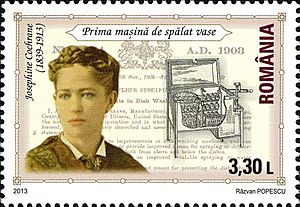Josephine Cochrane facts for kids
Quick facts for kids
Josephine Cochrane
|
|
|---|---|

Stamp of Romania, 2013
|
|
| Born |
Josephine Garis
March 8, 1839 Ashtabula County, Ohio, U.S.
|
| Died | August 3, 1913 (aged 74) |
| Known for | Inventor of a popular model of dishwasher |
| Spouse(s) |
William Cochran
(m. 1858) |
| Children | 2 |
Josephine Cochrane (born Josephine Garis) was an American inventor. She was born on March 8, 1839, and died on August 3, 1913. She invented the first successful hand-powered dishwasher. A mechanic named George Butters helped her build it.
Josephine got a patent for her invention on December 28, 1886. After that, she started her own company. It was called Garis-Cochrane Manufacturing Company. She wanted to make her dishwashers for everyone.
In 1893, Josephine showed her new machine at the World's Columbian Exposition in Chicago. Nine of her dishwashers were used in the fair's restaurants. Hotels and restaurants were very interested in her invention. She won an award for "best mechanical construction" at the fair. Her company grew by selling to businesses. In 1897, it was renamed Cochran's Crescent Washing Machine Company.
After Josephine's death in 1913, her company became part of KitchenAid. This happened when Hobart Manufacturing Company bought it. In 2006, Josephine Cochrane was honored. She was added to the National Inventors Hall of Fame. This was for her amazing invention, the dishwasher.
Contents
Josephine's Early Life
Josephine Garis was born in Ashtabula County, Ohio, on March 8, 1839. She grew up in Valparaiso, Indiana. Her father, John Garis, was a civil engineer. Her mother was Irene Fitch Garis. Josephine's grandfather was also an inventor.
She later moved to her sister's home in Shelbyville, Illinois. On October 13, 1858, she married William Cochrane. William had tried to find gold in California. He then became a successful merchant and politician. Josephine and William had two children, Hallie and Katharine.
In 1870, her family moved into a large house in Chicago. Josephine became part of Chicago's high society. After a dinner party, some valuable dishes got chipped. This happened while they were being washed by hand. This made Josephine want a better way to wash dishes. She also wanted to help tired housewives. She wanted to make washing dishes easier for them.
Inventing the Dishwasher
Before Josephine, others had tried to invent a dishwasher. In 1850, Joel Houghton made a hand-cranked dish soaker. In the 1860s, L. A. Alexander improved it. His machine used gears to spin dishes in water. But neither of these machines worked very well.
Josephine Cochrane's dishwasher eventually became a big success. But it took a lot of hard work and time. She faced many challenges as a female inventor. In 1883, her husband died. Josephine was left with little money and a lot of debt. This difficult time motivated her to create her invention. She needed to support herself financially.
Being a woman at that time made things even harder. She had to bring her invention to life all by herself. She needed to get a patent, find customers, and sell her product. This was very difficult for women back then. She worked hard with little money. She also had limited technical knowledge. It was tough to find skilled help to build her machine.
How Josephine's Dishwasher Worked
Josephine filed her first patent application on December 31, 1885. Then, she started building her first model. She designed it in a shed behind her house in Shelbyville, Illinois. George Butters, a mechanic, helped her build it. He later became an employee at her first factory.
To build the machine, she first measured her dishes. Then, she made wire compartments for them. Each compartment was designed for plates, cups, or saucers. These compartments were placed inside a wheel. The wheel lay flat inside a copper boiler. A motor turned the wheel. Hot, soapy water sprayed up from the bottom. It rained down on the dishes. Her dishwasher was the first to use water pressure to clean dishes. It did not use scrubbers. She received her patent on December 28, 1886.
Challenges and Success
Selling her dishwasher to regular homes was another challenge. The first dishwashers were quite expensive. They cost between $75 and $100. Most women would not spend that much on a kitchen item. Also, most homes back then did not have enough hot water for the machine.
However, years later, homes started getting bigger water heaters. This allowed Josephine to sell to housewives. This had been her main goal all along.
The World's Columbian Exposition in 1893 was a turning point. Many other companies failed that year. But the exposition helped Josephine's business. It was a great place to show off her invention. Many restaurants and hotels placed orders. Colleges and hospitals also started buying them later. Josephine's large dishwashers saved a lot of money and time for these businesses.
In 1898, she opened her own factory. George Butters was the manager. This helped her sell her machines across North America. Closer to her death, she thought about her journey. She admitted that if she knew how hard it would be, she might not have started. But she was glad she did.
Hotels and restaurants remained her main customers. Dishwashers did not become popular in homes until much later. This was after Josephine died in 1913 at age 74. In 1926, her company was sold to KitchenAid. KitchenAid is now part of Whirlpool Corporation.
Death and Recognition
Josephine Cochrane died in Chicago, Illinois, on August 3, 1913. She was 74 years old. She was buried in Glenwood Cemetery in Shelbyville, Illinois. In 2006, she was honored for her invention. She was added to the National Inventors Hall of Fame.
See also
 In Spanish: Josephine Cochrane para niños
In Spanish: Josephine Cochrane para niños

